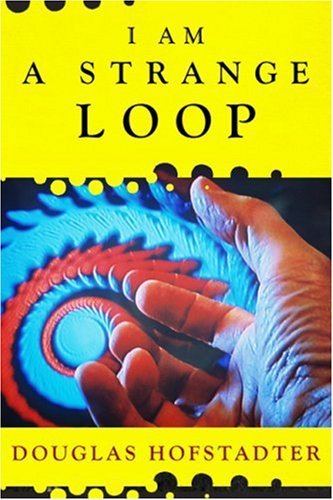Reviewed by
Jim Doran
University of Essex
 Doug Hofstadter's latest book, I am a Strange Loop, is partly a reworking of and partly a sequel to his celebrated Godel, Escher and Bach published back in 1979. It focuses on the "I" - the sense we all have of our own personal identity in relation to the rest of the world. Hofstadter's view is that this notion of "I", so fundamental to us all, is substantially an illusion and emergent from the material substrate. It is a brain created symbol, he argues, one of an indefinitely extensible set of symbols the brain creates from the input it receives. "I" is a consequence of the brain's ability to monitor itself, together with its computational inability to process fully detailed descriptions of itself. He connects this "strange loop" of self-reference to the notion of emergence, to Godel's famous incompleteness result and to Escher's drawings - hence his title.
Doug Hofstadter's latest book, I am a Strange Loop, is partly a reworking of and partly a sequel to his celebrated Godel, Escher and Bach published back in 1979. It focuses on the "I" - the sense we all have of our own personal identity in relation to the rest of the world. Hofstadter's view is that this notion of "I", so fundamental to us all, is substantially an illusion and emergent from the material substrate. It is a brain created symbol, he argues, one of an indefinitely extensible set of symbols the brain creates from the input it receives. "I" is a consequence of the brain's ability to monitor itself, together with its computational inability to process fully detailed descriptions of itself. He connects this "strange loop" of self-reference to the notion of emergence, to Godel's famous incompleteness result and to Escher's drawings - hence his title. Hofstadter's writing is everywhere lucid, interesting, idiosyncratic, entertaining, informative and thought provoking. In support of his argument he persuasively deploys personal reflections, anecdotes, analogies, lists, puns and neologisms. It is characteristic that five successive entries in the (excellent) index are: tallness vs. souledness, Taoism, Alfred Tarski, Tarzan and Jane, and Jacques Tati. And the book's argument is structured with great care. But there is not much that is truly original. At heart Hofstadter is attempting to use our developing understanding of the actual and potential structure and abilities of machines and brains to take forward an investigation that originated at least as far back as Empedocles: how to replace matter-mind dualism by materialism. In other words, how does one resolve the "mind-body problem"? He firmly plumps for scientific materialism of the currently fashionable variety, but finally admits that there remain "troubling issues" in understanding how the "strange loop" in the brain (or the "strange loop" pattern implemented by the brain) can explain the primacy of our experience of "I". After all, ALL we experience, know and feel is by way of "I". But for Hofstadter the alternative of some mysterious non-material essence that exists in addition to the material world raises far too many problems to be seriously considered. He regards it as "a non-scientific belief in magic". He does not even mention mentalism.
Often the book reads as a personal credo. Hofstadter essentially equates the "I" with self, consciousness, and with soul. And, importantly, he sees levels of soul. Some people have lots of soul, others rather less, dogs still less, and mosquitoes pretty well none. (Hofstadter reveals that he really doesn't think much of mosquitoes nor, perhaps more surprisingly, of John Searle or Dylan Thomas's poems) This notion of degrees of soul, as he explains at some length, has led him to become a vegetarian. And Hofstadter, as he also explains, is motivated partly by the tragically early death of his wife, which has led him to examine closely the idea that those we have loved live on for a time in our minds/brains. His investigation centres on the idea that "mental" representations of strange loops can also be strange loops.
This is a very personal book with a great deal to offer. As an entertaining and at times moving introduction to and development of recent thinking on self-awareness and consciousness by such writers as Dennett, Chalmers and Parfit, it will certainly appeal to and excite many readers. Yet there is much that seems relevant to Hofstadter's argument that is barely touched upon. Thus there is little reference to artificial intelligence models of cognition, meta-cognition and emotion, or to neuroscience and its distinctive and detailed view of the brain and its relationship to the mind (see, for example, Chris Frith's just published book, Making up the Mind). Nor is much said about social processes and social roles as determinants of the individual. And the notions of agents and multi-agent systems are clearly not on Hofstadter's radar. Yet it is surely beyond doubt that these various perspectives are slowly detailing precise ways in which Hofstadter's "I" symbol can come into being.
Return to Contents
of this issue
© Copyright Journal of Artificial Societies and Social Simulation, 2007